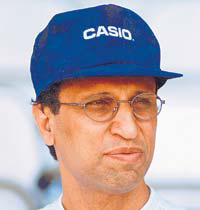
Asif Iqbal.
When I first saw the news on NDTV 24X7 news channel that it was, along with Toyota, sponsoring and organising an inter-university cricket tournament, I was greatly thrilled and delighted. It brought back to my memory the late 1950s, and early 1960s when we played the All-India Inter-University Cricket Tournament for the Rohinton Baria Trophy. Mind you, those days all the matches were played over three days and were all classified as first class matches.
In my first year (1959-60) four university teams played in the South Zone. Matches were all played in Madras at the Unversity Union grounds in Egmore and the Marina grounds. Both had matting wickets. The teams that played were Madras, Mysore, Osmania and Ceylon univeristy teams. We (Osmania ) beat Madras in the finals at the Marina grounds and this match is most remembered for the classic hundred that Asif Iqbal (later Pakistan captain) scored. For Madras University, P.K. Belliappa got a hundred in the second innings.
We played Bombay University in a semi-final at Pune. Those who played for Bombay were S.G. Adhikari, Ajit Wadekar, Dilip Sardesai, S.J. Diwakar (captain), Baloo Gupte and Ramakant Desai, to name a few. Bombay piled up 500 plus runs and we were bowled out for less than a hundred and conceded the match.
In the 1960s and 1970s, a majority of the cricketers who played for India literally graduated from the inter-university tournament. Though there was not enough money in the universities to provide excellent facilities, the importance of the tournament drove the players to bear all the inconveniences and hardships. When we were playing, Jaisimha was the captain and had already played for India in a Test match. But he stayed with us in the pavilion and slept on the floor and never grumbled at the Rs.4.50 that we got as meal allowance. Similary, Ramakant Desai of Bombay had also played for India but stayed with the Bombay team with six in a room.
It is a pity that the Rohinton Baria Tournament has lost all its sheen and the universities are not giving it enough importance and, over the years, with umpteen universities coming up, the attraction for a budding cricketer to play in Rohinton Baria is lost. I understand now it is played just to complete the formality as a part of an annual feature. It is just a ritual and formality that has to be gone through. I also understand that the system of enrolling talented sportsmen in various disciplines under the sports quota is not properly used or applied. Thus, talented sportsmen do not join the universities.
Talking purely for cricket, the moment a talented cricketer performs at some level, the kind of media attention that he gets makes him disinterested in pursuing any studies. Instead, he concentrates on the game full-time in the hunt for a lucrative contract somewhere. Also, the corporates have virtually stopped employing cricketers in their organisations.
Associated Cement Company of Bombay was the first to provide employment for cricketers. Players of the calibre of Polly Umrigar, Ramakant Desai, M.K. Mantri, Bapu Nadkarni, and Dilip Sardesai were all with ACC. And, for a while, even Ajit Wadekar and Sunil Gavaskar were with ACC. Then came State Bank of India in a very big way. They employed cricketers all over the country and, there was a time when the whole of the Indian team was from SBI.
Tata’s were another corporate and so were Nirlons and Mafatlals. The whole process was to give and take. The corporate provided security to the players to concentrate and play the game and, in return, the corporate got all the mileage in the media. The question arose as to how the corporate picked these players. Yes, by their respective performances in the inter-university tournament.
The game flourished. India did well at the international level and, when the players retired from active cricket, they retired to plum positions in their respective corporates.
Though I am not a fan of the T/20 format, since it is the order of the day, I accept it. I am of the old school and for me the longer format of the game is real cricket. That is a battle between bat and ball. But moving with the times, I am willing to accept the T/20 format, now that a beginning has been made for an inter-university T/20 tournament.
The BCCI and the University Sports Control Board should liaise with each other and work towards rebuilding the Rohinton Baria Trophy tournament of the past. The BCCI in future should also schedule a fixture for a Combined University team against visiting teams as was done in the past. Universities too should look out for talented sportsmen as they emerge from schools and enrol , encourage and promote them to bring laurels to the university to which they represent and belong to.
(Courtesy: Straight Bat)
|

